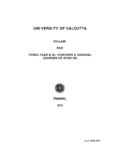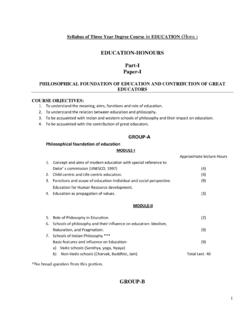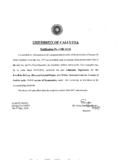Transcription of SYLLABUS F O R - University of Calcutta
1 University OF Calcutta . SYLLABUS . F. O. R. THREE-YEAR HONOURS. DEGREE COURSE OF STUDIES. MICROBIOLOGY. 2010. 2010-11. SYLLABUS for Microbiology Honours Part I. Paper I. Group A: Biomolecules Unit I 1. Stereochemistry 2. Carbohydrates 3. Amino acids Unit II 1. Protein 2. Nucleic Acids 3. Lipids Group B: Biophysical Chemistry and Biometry Unit I 1. Physicochemical properties of water 2. Thermodynamics 3. Microscopy 4. Radioactivity Unit II 1. Spectroscopy 2. Biometry Paper II. Group A: General Microbiology Unit I 1. Development of microbiology 2. position of microbes 3. Staining 4. Morphology and subcellular structures 5. Bacterial cell wall biosynthesis and structure Unit II 1. Eukaryotic microbes 2. Microbial nutrition 3. Microbial growth 4. Control of growth of microbes Group B: Practical Unit I 1.
2 Operation of Light-Microscope; oil-immersion objective 2. Preparation of culture,media,Cultivation of Microorganisms, Pure-culture, Staining techniques 3. Micrometry Unit II tests of carbohydrates 2. Separation of aminoacids 3. Estimation of amino acid 4. Biometry Detailed SYLLABUS Paper I. Group A: Biomolecules (50 marks). UNIT I. 1. Stereochemistry: (15). General concepts on: Plane of symmetry, centre and axis of symmetry; Concepts of chirality; optical isomerism; geometrical isomerism; DL, RS nomenclature; Projection formula (Fischer & Howarth); Isomers: anomers, epimers. Stereochemistry of cyclohexane: idea of axial & equatorial bonds (related to chair form conformation), Important chemical reactions relating to configurations, Mutarotation and its mechanism.
3 2. Carbohydrates: (15). Definition, classification and structural concept of: Monosaccharides: Hexoses (only Glucose), Pentoses (Ribose, Ribulose, Xylose). Disaccharides: Sucrose, Lactose, Maltose Amino Sugars: Glucosamine, Muramic Acid Inversion (hydrolysis) of cane sugar. Chemical reactions of monosaccharides (glucose & fructose , aldose and ketose) with HN03, Br2 - water, HI04, Phenylhydrazine. Principle of chemical estimation of sugar. Anomeric effect (Methylation effect). Polysaccharides: Chemical structure of Starch ( - amylose, amylopectin), glycogen & cellulose. Smith degradation and enzymic hydrolosis of -amylose & amylopectin. 3. Amino Acids: (10). Definition, classification, structure, stereochemistry of amino acids; Physico-chemical properties (Ionization & Biuret reaction) of amino acids.
4 Amphoteric molecule, Zwitterion, pK values; Isoelectric point, Electrophoresis, Formol titration of Glycine (only reaction &. principle). Reaction with Ninhydrin, FDNB, Dansyl & Dabsyl chloride, Fluorescamine, Van-slykes reaction. Reactions of carboxyl & amino groups. Synthesis of Glycine. Separation of amino acids by-Ion-exchange, Gel filtration, Paper Chromatography and Thin layer Chromatography. Peptides: peptide bond, biologically important peptides (glutathione, oxytocin-important functions). UNIT II. (15): Classification (Primary, Secondary, Tertiary, Quaternary- definition, examples) Forces that stabilize structure of proteins: H-bonds, hydrophobic interaction, electrostatic attraction, Van der Waal's interaction, dipole-dipole interaction. Types of proteins: i) Fibrous ( -helix, - sheet, collagen): definition and structure.
5 Ii) Globular (Haemoglobin, Myoglobin): definition & examples. iii) Simple proteins and conjugated protein: definition & examples physical denaturation and renaturation . 2. Nucleic acid: (15). Purine, pyrimidine - definition and structure. Nucleoside, nucleotide: definition and structure. DNA & RNA: Double helical structure. A-DNA, B-DNA & Z-DNA (structure and differences). Chemical Properties: Hydrolysis (acid, alkali), enzymatic hydrolysis of DNA. General structure and types of RNA (tRNA, mRNA, rRNA). Viscosity, Buoyant density. Hyperchromic effect. Cot curve, Tm. (10). Definition, nomenclature, classification - (simple, complex, derived lipids - structure &. example) phospholipids, glycolipids, - (structure, composition); hydrolysis, saponification, saponification number, I2 number, acetylation, acetyl number, volatile fatty acid number - definition and related problems, Isomerism - cis-trans isomerism.
6 Fatty acids: Saturated (palmitic acid, stearic acid), unsaturated (oleic acid): Structure of free fatty acids (example only). General chemical reaction of fatty acids - esterification. Hydrogenation and halogenations Suggested textbooks: , IL. Organic Chemistry, Part I and Part II. Group B. Biophysical Chemistry and Biometry (50 marks). UNIT I. 1. Physico-chemical properties of water : (10). Ionic product of water; pH - definition, effect of pH in enzyme catalyzed reaction. Acids, bases and buffers in biological system; Arrhenius, Bronsted-Lowry theories of acid and bases. Polyprotic acids, ampholytes, dissociation of polyprotic acid; titrable and true acidity. Surface tension, viscosity: application to biomolecules. 2. Thermodynamics: (15). Zero-th law, 1st law & 2nd law of thermodynamics: application in biological systems, Concept of free energy, standard free energy change.
7 Equilibrium constant; enthalpy;. entropy. Transport across membrane - passive diffusion, facilitated diffusion & active transport - (definition and examples); gradient of chemical potential as driving force in transport, equilibria and transport across membranes; diffusion, osmosis, sedimentation, osmotic pressure. Donnan equilibrium, diffusion potential, membrane potential. Electrophoresis. 3. Microscopy: (5). General principles of optics in relation to microscopy; different components of light wave (UV, IR, visible); principles and applications of Compound Microscope; Light Microscope; Dark field Mircroscope; Bright field Microscope; Phase Contrast Microscope; Fluorescent Microscope; Electron Microscope; Resolving power; Numerical aperture:Chromatic Aberration.
8 4. Fundamentals of radioactivity: (10). Law of Radioactivity, Decay constant, half life, average life. Properties of , , . radiations, unit of radioactivity, radioactive carbon dating. Applications of radioactive isotopes (14C, 3. H, 32. P) in biological systems, (in Radioimmunoassay, glucose metabolism, DNA synthesis). Principle of liquid scintillation counter. Radiation absorption- biological effectiveness- Linear energy transfer- radiation protection and safety aspects. UNIT II. 1. Spectrophotometry: (15). Concept of electromagnetic radiations - UV, visible, IR. Orbital theory: Bonding and antibonding; simple association of 1t orbital to form TT. orbitals. Concept of chromophore - Wit's chromophore theory, auxochorome, red shift, blue shift, Lambert-Beer's law - derivation & deviation; absorptivity, line diagram &.
9 Working principle of spectophotometer. Extinction co-officient. Instrumentation and application of UV and visible spectrophotometry, Light Scattering, fluorescence spectroscopy, fluorescence energy transfer, infrared spectroscopy. 2. Biometry: (15). Introduction : Types of Biological Data, Population and samples. Descriptions of Samples and Populations: Frequency Distributions, Descriptive statistics (measures of Central tendency and measures of Dispersion, Boxplot). Probability: Introductory concepts, Binomial distribution, Random sampling Distribution Theory: Normal distribution and sampling distributions. Statistical Inference: Statistical estimation, standard error of the mean, confidence interval and hypothesis testing of the population mean t test.
10 Brief discussions on the comparison of two independent population means. The Chi square test and its applications. Analysis of Variance: Multi sample Hypotheses Linear Regression and Correlation. Suggested text books: 1. Tinoco, Sauer and Wang, Physical Chemistry, Principles and Applications in Biological Sciences, Prentice Hall, 4th Edition (2001). 2. Zar, JH., Biostatistical analysis, Pearson Education. 3. Atkins, Physical Chemistry for the Life Sciences, Freeman (2005). 4. Atkins, The Elements of Physical Chemistry, Freeman, 3rd Edition (2000). 5. Cantor & Schimmel, Biophysical Chemistry, Part I, II, III, Freeman Press (1980- 1981). 6. Eisenberg & Crothers, Physical Chemistry with Applications to the Life Sciences, Benjamin/Cummings Publishing Co. (1979).









